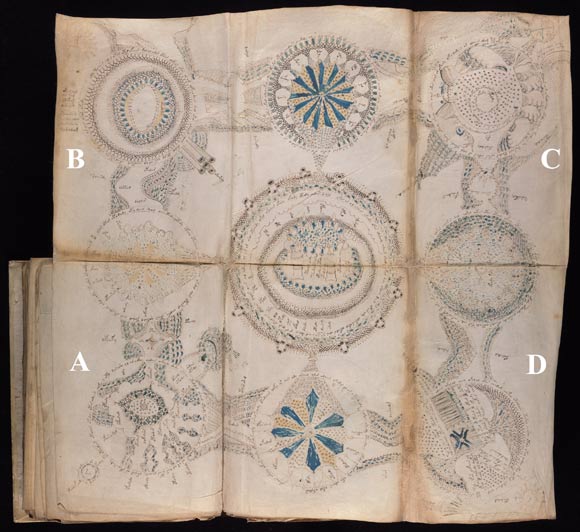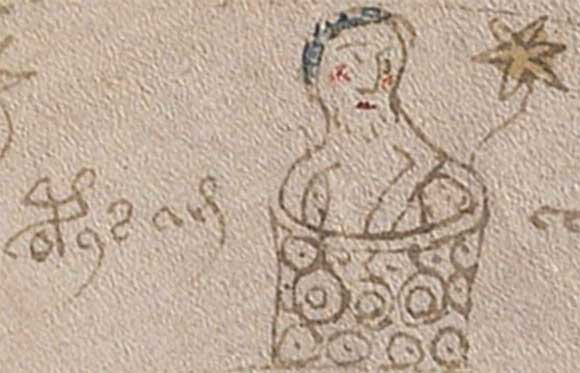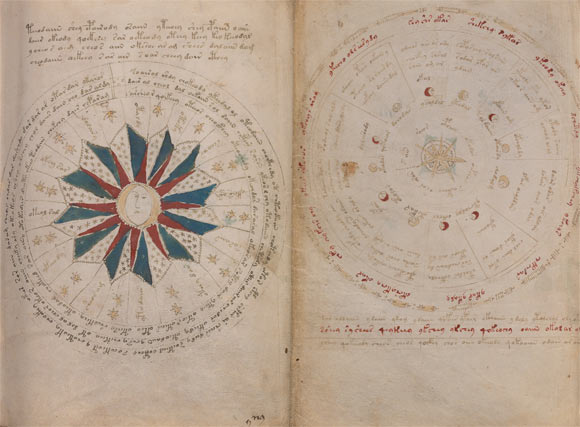The Voynich manuscript, sometimes described as the ‘world’s most mysterious text,’ may be written in proto-Romance, a language that arose from a blend of spoken Latin (Vulgar Latin) and other languages across the Mediterranean during the early Medieval period following the collapse of the Roman Empire and subsequently evolved into the many Romance languages. The manuscript originates from Castello Aragonese, an island castle and citadel off Ischia, Italy, and was compiled by a Dominican nun as a source of reference for Maria of Castile, Queen of Aragon, according to research by University of Bristol’s Dr. Gerard Cheshire.
The Voynich manuscript, named after the Polish-American antiquarian book dealer Wilfrid M. Voynich, who acquired it in 1912, is a small book 23.5 x 16.2 cm of about 240 pages.
Nearly every page of the manuscript contains scientific and botanical drawings in various shades of green, brown, yellow, blue, and red. The vellum used in the book was carbon dated to 1404-1438.
Although the purpose and meaning of the manuscript had eluded scholars for decades, it took Dr. Cheshire two weeks to identify the language and writing system of the famously inscrutable document.
“I experienced a series of ‘Eureka!’ moments whilst deciphering the code, followed by a sense of disbelief and excitement when I realized the magnitude of the achievement, both in terms of its linguistic importance and the revelations about the origin and content of the manuscript,” Dr. Cheshire said.
“The Voynich manuscript is written in proto-Romance — ancestral to today’s Romance languages including Portuguese, Spanish, French, Italian, Romanian, Catalan and Galician. The language used was ubiquitous in the Mediterranean during the Medieval period, but it was seldom written in official or important documents because Latin was the language of royalty, church and government. As a result, proto-Romance was lost from the record, until now.”
“The manuscript’s alphabet is a combination of unfamiliar and more familiar symbols. It includes no dedicated punctuation marks, although some letters have symbol variants to indicate punctuation or phonetic accents. All of the letters are in lower case and there are no double consonants.”
“It includes diphthong, triphthongs, quadriphthongs and even quintiphthongs for the abbreviation of phonetic components. It also includes some words and abbreviations in Latin.”
![The Voynich manuscript, folio 53r: the oblong-leaved sundew (Drosera intermedia); the first line of the accompanying text reads: ‘la naza éo eme ona oma nor nais t’ (the pregnancy/baby it’s to acquire good growth as for normal birth); the words survive in various Romance languages and Latin: la naza (Galician) éo (Portuguese) eme (Latin) ona (Galician) oma (Greek) nor [mais] (Portuguese) nais (Old French) t [terminus] (Latin); the plant is native to Northern Italy and Iberia, where it grows in marshes and bogs. Drosera contains substances known as flavonoids and quinones, which have an antibiotic, antiviral, antimicrobial and antifungal effect, so they would have helped to ward off infections and infestations during pregnancy. Image credit: Beinecke Library, Yale University.](https://cdn.sci.news/images/2019/05/image_7190_2-Voynich-Manuscript.jpg)
The Voynich manuscript, folio 53r: the oblong-leaved sundew (Drosera intermedia); the first line of the accompanying text reads: ‘la naza éo eme ona oma nor nais t’ (the pregnancy/baby it’s to acquire good growth as for normal birth); the words survive in various Romance languages and Latin: la naza (Galician) éo (Portuguese) eme (Latin) ona (Galician) oma (Greek) nor [mais] (Portuguese) nais (Old French) t [terminus] (Latin); the plant is native to Northern Italy and Iberia, where it grows in marshes and bogs. Drosera contains substances known as flavonoids and quinones, which have an antibiotic, antiviral, antimicrobial and antifungal effect, so they would have helped to ward off infections and infestations during pregnancy. Image credit: Beinecke Library, Yale University.
More specifically, the manuscript was compiled by a Dominican nun as a source of reference for Maria of Castile, Queen of Aragon, who happens to have been great aunt to Catherine of Aragon.

The Voynich manuscript, folio 85v and 86r, a foldout pictorial map: vignette A illustrates the erupting volcano that prompted the rescue mission and the drawing of the map; it rose from the seabed to create a new island given the name Vulcanello, which later became joined to the island of Vulcano following another eruption in 1550; vignette B depicts the volcano of Ischia, vignette C shows the islet of Castello Aragonese, and vignette D represents the island of Lipari; each vignette includes a combination of naïvely drawn and somewhat stylized images along with annotations to explain and add detail; the other five vignettes describe further details of the story. Image credit: Beinecke Library, Yale University.
“Within the Voynich manuscript there is a foldout pictorial map that provides the necessary information to date and locate the origin of the manuscript,” Dr. Cheshire said.
“It tells the adventurous, and rather inspiring, story of a rescue mission, by ship, to save the victims of a volcanic eruption in the Tyrrhenian Sea that began on the evening of the 4 February 1444.”
“The manuscript originates from Castello Aragonese, an island castle and citadel off Ischia, and was compiled for Maria of Castile, Queen of Aragon, who led the rescue mission as regent during the absence of her husband, King Alfonso V of Aragon who was otherwise occupied, having only recently conquered and then taken control of Naples in February 1443.”

The Voynich manuscript, folio 70v, detail: an illustration of a bearded monk in his washtub, from the monastery where the manuscript was created; the words read: opat a sa (it is abbot); his is one of very few male faces seen in the manuscript; the word opát survives to mean abbot in Polish, Czech and Slovak, demonstrating that proto-Romance reached as far as Eastern Europe; in Western Europe other variants survive: abat (Catalan), abad (Spanish), abbé (French), whilst the Latin is ‘abbas;’ this also demonstrates the phonetic overlap between the sounds ‘p’ and ‘b’ in the manuscript alphabet. Image credit: Beinecke Library, Yale University.
“The island of Ischia is historically famous for its hot volcanic spas, which exist to this day. The manuscript has many images of naked women bathing in them, both recreationally and therapeutically.”
“There are also images of Queen Maria and her court conducting trade negotiations whilst bathing. Clearly the spa lifestyle was highly regarded as a form of physical cleansing and spiritual communion, as well as a general means of relaxation and leisure.”
![The Voynich manuscript, folio 82r, detail: two women dealing with five children in a bath; the words describe different temperaments: tozosr (buzzing: too noisy), orla la (on the edge: losing patience), tolora (silly/foolish), noror (cloudy: dull/sad), or aus (golden bird: well behaved), oleios (oiled: slippery); these words survive in Catalan [tozos], Portuguese [orla], Portuguese [tolos], Romanian [noros], Catalan [or aus] and Portuguese [oleio]; the words orla la describe the mood of the woman on the left and may well be the root of the French phrase ‘oh là là,’ which has a very similar sentiment. Image credit: Beinecke Library, Yale University.](https://cdn.sci.news/images/2019/05/image_7190_5-Voynich-Manuscript.jpg)
The Voynich manuscript, folio 82r, detail: two women dealing with five children in a bath; the words describe different temperaments: tozosr (buzzing: too noisy), orla la (on the edge: losing patience), tolora (silly/foolish), noror (cloudy: dull/sad), or aus (golden bird: well behaved), oleios (oiled: slippery); these words survive in Catalan [tozos], Portuguese [orla], Portuguese [tolos], Romanian [noros], Catalan [or aus] and Portuguese [oleio]; the words orla la describe the mood of the woman on the left and may well be the root of the French phrase ‘oh là là,’ which has a very similar sentiment. Image credit: Beinecke Library, Yale University.
His paper was published online April 29 in the journal Romance Studies.
_____
Gerard Cheshire. The Language and Writing System of MS408 (Voynich) Explained. Romance Studies, published online April 29, 2019; doi: 10.1080/02639904.2019.1599566








